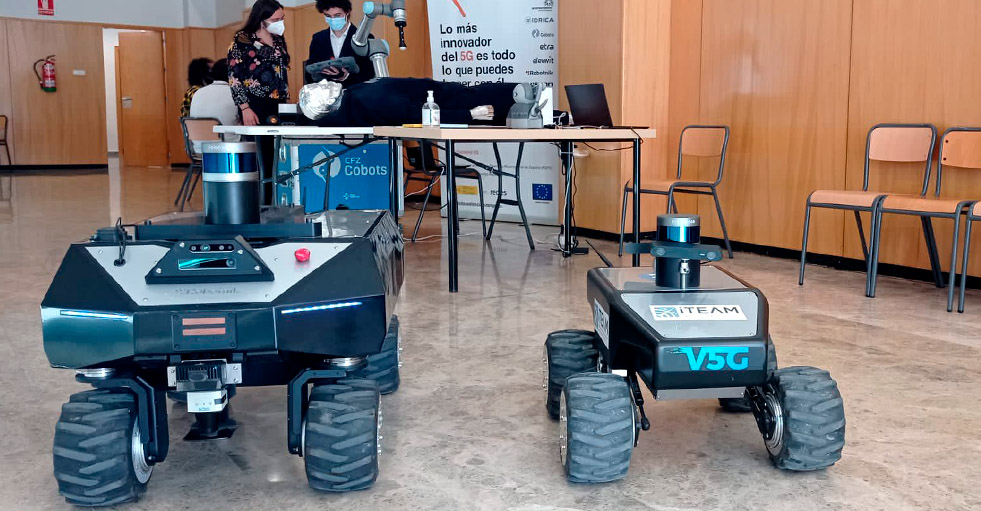Robotnik is one of the partners that are carrying out the development of different pilot tests around 5G technology and robotics in Spain.
Robotnik, Orange, CFZ Cobots, Elewit, Visyon, Aracnocóptero or Etra, are some of the partners that are carrying out the development of different pilot tests around 5G uses in Valencia, Spain as part of the 5G PILOTS project. The aim is to boost the automation of different industrial sectors by integrating 5G technology in collaborative mobile robots.
5G PILOTS is part of the National 5G Plan, a programme for the development of 5G technology pilot projects run by the public entity Red.es, promoted by the Ministry of Economic Affairs and Digital Transformation and co-financed by the European Regional Development Fund (ERDF), with a budget of 10 M€.
The project includes a total of 15 use cases developed by the different members of the joint venture, including Robotnik. In the institutional event held last Monday 14th, all of them were presented and 3 specific demonstrations were carried out, including the two use cases in which Robotnik participates.
Mobile robotics and 5G in Spain
The two cases using 5G and robotics technology in Spain, in which Robotnik participates are:
1. Use Case 6: Robotics – Remote Fleet Management of AGVs.
This 5G and Robotic technology case is implemented in two pilots in industrial manufacturing plants (both indoor and outdoor). The first one is FERMAX, where the RB-VOGUI robots will perform a task of supplying production points from the warehouse (indoor transport) and the second one is FAURECIA, where the robot will perform a task of transporting airbag racks. Up to now, work is being carried out on the design of the transport trolleys and the robot-to-trolley docking system to carry out the transport, on the indoor and outdoor location and navigation system (3D SLAM), on the user interface and on the implementation of a fleet manager in the cloud, which will later be tested on the edge.
As soon as 5G connectivity is available on the UPV Campus, the first communication, fleet management and telecontrol tests of both use cases will begin, as well as preliminary operational and validation tests prior to the implementation of the pilots.
2. Use Case 7: Robotics – Remote Inspection.
The inspection robotics use case focuses on the autonomous inspection of electrical substations and catenary for FGV (Ferrocarrils of the Generalitat Valenciana). Work is currently underway on the configuration of sensors and manufacture of the robot, on the programming and configuration of the robot for this application, on the organisation of a platform for data storage and on the integration of the 5G communications system with the remote inspection robot.
Partners in use cases 6 and 7
Robotnik provides robotic technology at hardware and software level for both use cases. Specifically, Robotnik provides a SUMMIT-XL robot (inspection) and a fleet of RB-VOGUI robots (Fleet Management System), as well as the software that includes among other modules such as the fleet manager, on-board software for localisation, navigation, mission management, HMI, etc.
Iteam is responsible for the development and integration of the 5G communications system based on Robotnik’s hardware and software.
Intel is Orange’s partner in use case 6 (Fleet Management – AGVs) and provides cloud computing algorithms that process data obtained from its sensors.
Finally, Orange is the network provider and Huawei is the infrastructure hardware provider.
5G marks the future of collaborative mobile robotics and is a major breakthrough for the industry. Indeed, as discussed last year, ‘the European Commission published a Recommendation calling on Member States to boost investment in very high capacity broadband connectivity infrastructure, including 5G, which is the cornerstone of the digital transformation and an essential pillar of the recovery. The timely deployment of 5G networks will offer significant economic opportunities in the coming years as it is a crucial asset for European competitiveness and sustainability, as well as an important enabler of future digital services.’ As the official website reads.
What does 5G bring to mobile robotics?
The inspection robotics and fleet management pilots are very representative examples where the introduction of 5G will play a disruptive role. It is an unbeatable framework to validate and test the capabilities of this new technology, which undoubtedly brings innumerable advantages for collaborative mobile robotics.
What 5G technology brings to autonomous service robots:
- High bandwidth: required for data, video and audio streams, both for telecontrol and for cloud or edge processing.
- Low latency and guaranteed latency: this opens up the possibility of teleoperation (and remote presence) to levels previously impossible. It also enables centralised fleet control, reducing computational needs on robots.
- Cloud computing: the robot does not have to have large processing capabilities, it can rely on AI algorithms or sensor processing in the cloud, allowing for a cheaper, more versatile and easier to install, cheaper and less energy consuming product.
- Much smoother and higher quality teleoperation:
With the pilots being developed, the aim is to validate the above advantages and measure the performance in real use cases.




